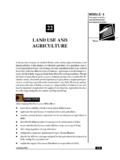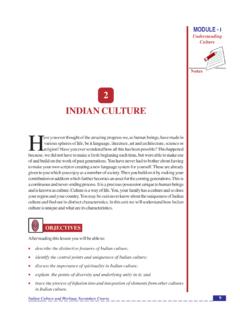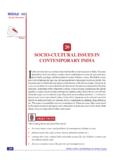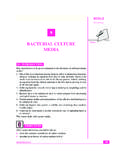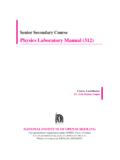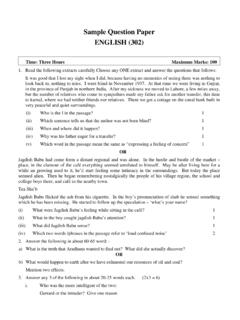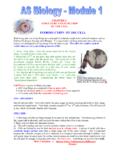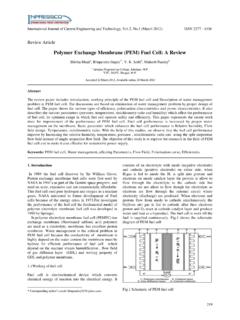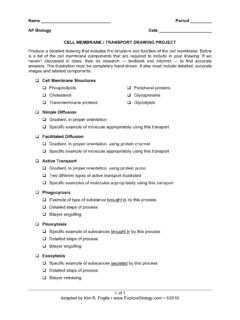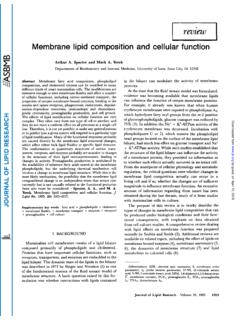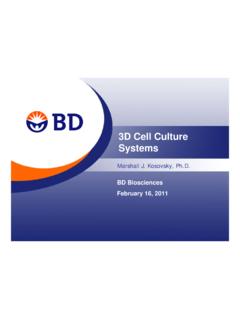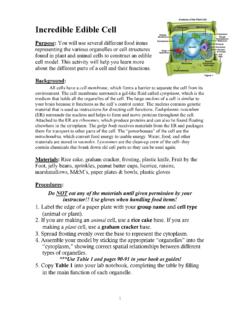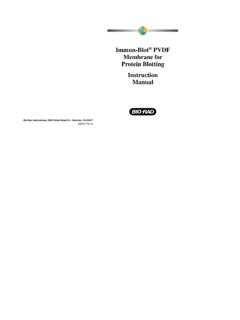Transcription of Notes CELL – STRUCTURE AND FUNCTION
1 Cell STRUCTURE and FUNCTION 79 BIOLOGYN otesMODULE - 1 Diversity and Evolutionof Life4 CELL STRUCTURE AND FUNCTIONINTRODUCTIONAll organisms are composed of structural and functional units of life called cells .The body of some organisms like bacteria, protozoans and some algae is made upof a single cell whereas the body of higher fungi, plants and animals are composedof many cells . Human body is built of about one trillion vary in size and STRUCTURE as they are specialized to perform different the basic components of the cell are common to all biological cells . This lessondeals with the STRUCTURE common to all types of the cells . You will also learn aboutthe kinds of cell division and the processes involved therein in this completing this lesson, you will be able to :zjustify that cell is the basic structural and functional unit of all organisms;zlist the components of the cell and state cell theory;zdifferentiate between prokaryotic and eukaryotic cells ;zdifferentiate between plant and animal cells ;zillustrate the STRUCTURE of plant and animal cells by drawing labelled diagrams;zdescribe the STRUCTURE and functions of plasma membrane , cell wall, endoplasmicreticulum (ER), cilia, flagella, nucleus, ribosomes, mitochondria, chloroplasts,golgi body, peroxisome, glyoxysome and lysosome.
2 Zdescribe the general importance of the cell molecules-water, mineral ions,carbohydrates, lipids, amino acids, proteins, nucleotides, nucleic acids, enzymes,vitamins, hormones, steroids and alkaloids;zjustify the need for cell division;zdescribe various phases of cell cycle;zexplain the term karyotype and mention the karyotype analysis and STRUCTURE and FunctionBIOLOGYMODULE - 1 Diversity and Evolutionof Life THE CELL AND CELL Landmarks in the study of a cellSoon after Anton Van Leeuwenhoek invented the microscope, Robert Hooke in1665 observed a piece of cork under the microscope and found it to be made ofsmall compartments which he called cells (Latin cell = small room). In 1672,Leeuwenhoek observed bacteria, sperms and red blood corpuscles, all of which werecells.
3 Much later, in 1831, Robert Brown, an Englishman observed that all cells hada centrally positioned body which he termed the The cell theoryIn 1838 Schleiden and Theodore Schwann formulated the cell theory. Whichmaintains that:zall organisms are composed of is the structural and functional unit of life, andzcells arise from pre-existing cells vary considerably, in shapes and sizes ( ). Nerve cells of animalshave long extensions. They can be several centimeter in length. Muscle cells areelongated in shape. Egg of the ostrich is the largest cell (75 mm). Some plant cellshave thick walls. There is also wide variation in the number of cells in The CellA cell may be defined as a unit of protoplasm bound by a plasma or cell membraneand possessing a nucleus.
4 Protoplasm is the life giving substance and includes thecytoplasm and the nucleus. The cytoplasm has in it organelles such as ribosomes,mitochondria, golgi bodies, plastids, lysosomes and endoplasmic reticulum. Plantcells have in their cytoplasm, large vacuoles containing non-living inclusions likecrystals, and pigments. The bacteria have neither defined cell organelles nor a wellformed nucleus. But every cell has three major components:zplasma membranezcytoplasmzDNA (naked in bacteria) and enclosed by a nuclear membrane in all otherorganismsTwo basic types of cellsCytologists recognize two basic types of cells (Fig. ). Their differences have beentabulated below in Table Organisms which do not possess a well formed nucleusare prokaryotes such as the bacteria. All others possess a well defined nucleus,covered by a nuclear membrane .
5 They are STRUCTURE and FUNCTION 81 BIOLOGYN otesMODULE - 1 Diversity and Evolutionof LifeTable Differences between Eukaryotic and Prokaryotic cellsEukaryotic cell (eu = true, karyon = nucleus)Prokaryotic cell (Pro = early/primitive)1. Nucleus distinct, with well formed1. Nucleus not distinct, it is in the formnuclear a nuclear zone nucleoid . Nuclearmembrane Double-membraned cell organelles2. Single-membraned cell bodies like(Chloroplasts, mitochondria, nucleus)mesosomes present. Endoplasmicand single membraned (Golgi apparatus,reticulum, plastids, nitochondrialysosomes, vacuole, endoplasm reticulum)microbodies like lysosomes, andare presentGolgi body Ribosomes - 80 S3. Ribosomes - 70 S4. Distinct compartments in the cell4.
6 No the cytoplasm and the nucleus5. Depending upon the species number of5. There is only one chromosome per per nucleus varies fromtwo to Each chromosome is linear with its two6. The chromosome is circular and remainsends to cell membrane at one Each chromosome has one linear double-7. The chromosome has single double-strandedstranded DNA complexed with histonescircular DNA molecule and is not associatedwith Each chromosome has one centromere8. The chromosome lacks a divides a chromosome into twoarms. However, if the centromere isterminal, the chromosome would haveonly one armFig. Eukaryotic CellFig. Prokaryotic Cell(As seen in an electron micrograph.)Svedberg unitWhen the cell is fractionated or broken down into its components by rotatingin an ultracentrifuge at different speeds the ribosomes of eukaryotic andprokaryotic cells sediment (settle down) at different speeds.
7 The coefficient ofsedimentation is represented in Svedberg unit and is depicted as plant cell and the animal cell also differ in several respects as given in and shown in Fig. STRUCTURE and FunctionBIOLOGYMODULE - 1 Diversity and Evolutionof Life 82 NotesTable: Differences between plant cell and animal cellPlant cell 1. Cellulose cell wall present external to cellmembrane. 2. Vacuoles are usually large. 3. Plastids present. 4. Golgi body present in the form of unitsknown as dictyosomes. 5. Centriole Generalised plant cellFig. Generalised animal cellINTEXT QUESTIONS From where do new cells arise?..2. Name the scientists who proposed the cell theory ..3. Name an organelle which a plant cell has but an animal cell does Give two points of difference between a prokaryotic cell and a eukaryotic COMPONENTS OF THE CELLThe major components of the cell are (1) cell membrane , (2) cytoplasm, and (3) Cell membrane (Plasma membrane )Each cell has a limiting boundary, the cell membrane , plasma membrane orplasmalemma.
8 It is a living membrane , outermost in animal cells but internal to cellwall in plant is flexible and can fold in (as in food vacuoles of Amoeba) or fold out (as in theformation of pseudopodia of Amoeba)Animal cell1. No cell wall, outermost STRUCTURE is cellmembrane or plasma membrane2. Generally vacuoles are absent and ifpresent, are usually Plastids Golgi body well developed having 2cisternae5. Centriole STRUCTURE and FUNCTION 83 BIOLOGYN otesMODULE - 1 Diversity and Evolutionof LifeThe plasma membrane is made of proteins and lipids and several models wereproposed regarding the arrangement of proteins and lipids. The fluid mosaic modelproposed by Singer and Nicholson (1972) is widely accepted. It is represented inFig to the fluid mosaic model,(i) The plasma membrane is composed of a lipid bilayer of phospholipid moleculesinto which a variety of globular proteins are embedded.
9 (ii)Each phospholipid molecule has two ends, an outer head hydrophilic waterattracting, and the inner tail pointing centrally hydrophobic, water repelling(iii)The protein molecules are arranged in two different ways:(a) Peripheral proteins or extrinsic proteins: these proteins are present on theouter and inner surfaces of lipid bilayer.(b) Integral proteins or intrinsic proteins: These proteins penetrate the lipidbilayer partially or The fluid mosaic model of cell (i) The plasma membrane encloses the cell contents.(ii) It provides cell shape (in animal cells ) the characteristic shape of red bloodcells, nerve cells , and bone cells .(iii) It allows transport of certain substances into and out of the cell but not allsubstances so much it is termed selectively permeable.
10 Transport of small molecules (such as glucose, amino acids, water, mineral ionsetc).Small molecules can be transported across the plasma membrane by any one of thefollowing three methods:(i)Diffusion : molecules of substances move from their region of higherconcentration to the regions of lower concentration. This does not requireenergy. Example : absorption of glucose in a cell.(ii)Osmosis: movement of water molecules from the region of their higherconcentration to the region of their lower concentration through a semipermeableNon-polartailPolarheadProte in molecule onone side of themembrane onlyLipid moleculePlasma membranein cross-sectionGlycoproteinGlycolipidLipid bilayerCholesterolProtein molecule that traversesthe membrane and is exposedat both surfacesCell STRUCTURE and FunctionBIOLOGYMODULE - 1 Diversity and Evolutionof Life 84 Notesmembrane.

